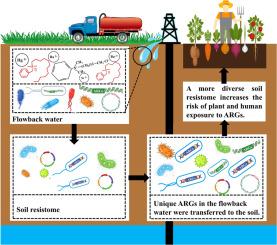Dissemination mechanisms of unique antibiotic resistance genes from flowback water to soil revealed by combined Illumina and Nanopore sequencing
IF 12.4
1区 环境科学与生态学
Q1 ENGINEERING, ENVIRONMENTAL
引用次数: 0
Abstract
As a byproduct of shale gas extraction, flowback water (FW) is produced in large quantities globally. Due to the unique interactions between pollutants and microorganisms, FW always harbor multiple antibiotic resistance genes (ARGs) that have been confirmed in our previous findings, potentially serving as a point source for ARGs released into the environment. However, whether ARGs in FW can disseminate or integrate into the environmental resistome remains unclear. In this study, unique ARGs from FW were identified, and the ARG profiles in soil and FW-spiked soil were compared using a combination of Illumina and Nanopore sequencing. The results indicated that the total abundance of the soil resistome increased by 30.8 % in soil contaminated with FW. Of this increase, 11.1 % was attributable to the integration of exogenous ARGs from FW into the soil resistome. Sequence alignment at the gene level further confirmed the successful integration of 20 unique ARG sequences classified as multidrug and vancomycin resistance genes into the soil resistome. These 20 ARG sequences were detected only in the FW. Multiple lines of evidence indicated that horizontal gene transfer dominated ARG dissemination in soil contaminated by FW. This conclusion is supported by the discrepancy between changes in mobile ARGs and host abundance, the upregulation of oxidative stress-related genes (SOD1 and SOD2) and the SOS response (lexA and recA), as well as the upregulation of genes related to quorum sensing (virD4, virB9, and virB3) and naked DNA uptake (pilD, pilT, and pilQ).


Illumina和Nanopore联合测序揭示了独特的抗生素抗性基因从返排水到土壤的传播机制
作为页岩气开采的副产品,返排水在全球范围内大量产生。由于污染物与微生物之间独特的相互作用,FW总是含有多种抗生素耐药基因(ARGs),这些基因在我们之前的研究中已经得到证实,可能是释放到环境中的ARGs的点源。然而,FW中的ARGs是否能够传播或整合到环境抵抗组中尚不清楚。在本研究中,我们鉴定了来自FW的独特ARG,并使用Illumina和Nanopore测序相结合的方法比较了土壤和FW刺入土壤中的ARG谱。结果表明,土壤抗性组的总丰度在土壤中增加了30.8%。其中,11.1%归因于来自FW的外源ARGs整合到土壤抗性组中。基因水平的序列比对进一步证实了20个独特的多药和万古霉素耐药基因ARG序列成功整合到土壤抗性组中。这20个ARG序列仅在FW中检测到。多线索证据表明,水平基因转移在FW污染土壤中以ARG传播为主。移动ARGs与宿主丰富度的差异、氧化应激相关基因(SOD1和SOD2)和SOS反应(lexA和recA)的上调以及群体感应相关基因(virD4、virB9和virB3)和裸DNA摄取(pilD、pilT和pilQ)的上调支持了这一结论。
本文章由计算机程序翻译,如有差异,请以英文原文为准。
求助全文
约1分钟内获得全文
求助全文
来源期刊

Water Research
环境科学-工程:环境
CiteScore
20.80
自引率
9.40%
发文量
1307
审稿时长
38 days
期刊介绍:
Water Research, along with its open access companion journal Water Research X, serves as a platform for publishing original research papers covering various aspects of the science and technology related to the anthropogenic water cycle, water quality, and its management worldwide. The audience targeted by the journal comprises biologists, chemical engineers, chemists, civil engineers, environmental engineers, limnologists, and microbiologists. The scope of the journal include:
•Treatment processes for water and wastewaters (municipal, agricultural, industrial, and on-site treatment), including resource recovery and residuals management;
•Urban hydrology including sewer systems, stormwater management, and green infrastructure;
•Drinking water treatment and distribution;
•Potable and non-potable water reuse;
•Sanitation, public health, and risk assessment;
•Anaerobic digestion, solid and hazardous waste management, including source characterization and the effects and control of leachates and gaseous emissions;
•Contaminants (chemical, microbial, anthropogenic particles such as nanoparticles or microplastics) and related water quality sensing, monitoring, fate, and assessment;
•Anthropogenic impacts on inland, tidal, coastal and urban waters, focusing on surface and ground waters, and point and non-point sources of pollution;
•Environmental restoration, linked to surface water, groundwater and groundwater remediation;
•Analysis of the interfaces between sediments and water, and between water and atmosphere, focusing specifically on anthropogenic impacts;
•Mathematical modelling, systems analysis, machine learning, and beneficial use of big data related to the anthropogenic water cycle;
•Socio-economic, policy, and regulations studies.
 求助内容:
求助内容: 应助结果提醒方式:
应助结果提醒方式:


